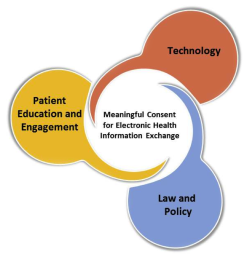 HealthIT.gov Add Meaningful Consent Tools
HealthIT.gov Add Meaningful Consent Tools
HHS announced the launch of an online resource to help health care providers effectively engage patients in choosing how they want their electronic patient health information shared. Known as Meaningful Consent, the site addresses the laws, policies and issues related to the electronic exchange of health information, also known as health information exchange, or HIE. The site includes strategies and tools that can be used to engage and educate patients. This information is designed for providers, certain health information organizations and other implementers of health information technology.
The new Meaningful Consent site includes background, lessons learned, videos and customizable tools from the eConsent pilot project that was completed by the HHS Office of the National Coordinator for Health Information Technology (ONC) in March of 2013. The pilot project tested the use of tablet computers to inform patients about options available to them when they consider whether to electronically share their health information through HIE.
The Meaningful Consent site builds upon the 2011 recommendations from ONC’s Health Information Technology Policy Committee (HITPC), which called on ONC to inform, collect, and evaluate the information patients need to make an informed choice about electronic exchange of their health information.
In recognition that patients are increasingly engaged in their health care, HHS encourages communication and education of patients in many areas, including electronically receiving and sharing their health information. Adequately informing patients of these new models for exchange and giving patients the choice whether to participate is one means of ensuring that patients trust these technologies.
On the site you will find:
- Patient Education and Engagement – Educating patients about topics including their consent options, who may release their information and how, and the significance of the consent choice.
- Technology – Using technology to capture and maintain patient consent decisions, identify which sensitive portions of patient information are restricted from access, and communicate these restrictions electronically with others.
- Law and Policy – Ensuring alignment with federal and state law and other legal and policy requirements pertaining to consent, personal choice, and confidentiality.
Visit the Meaningful Consent website today. Download and customize the tools used in the eConsent Trial Project at the eConsent Toolkit website.
